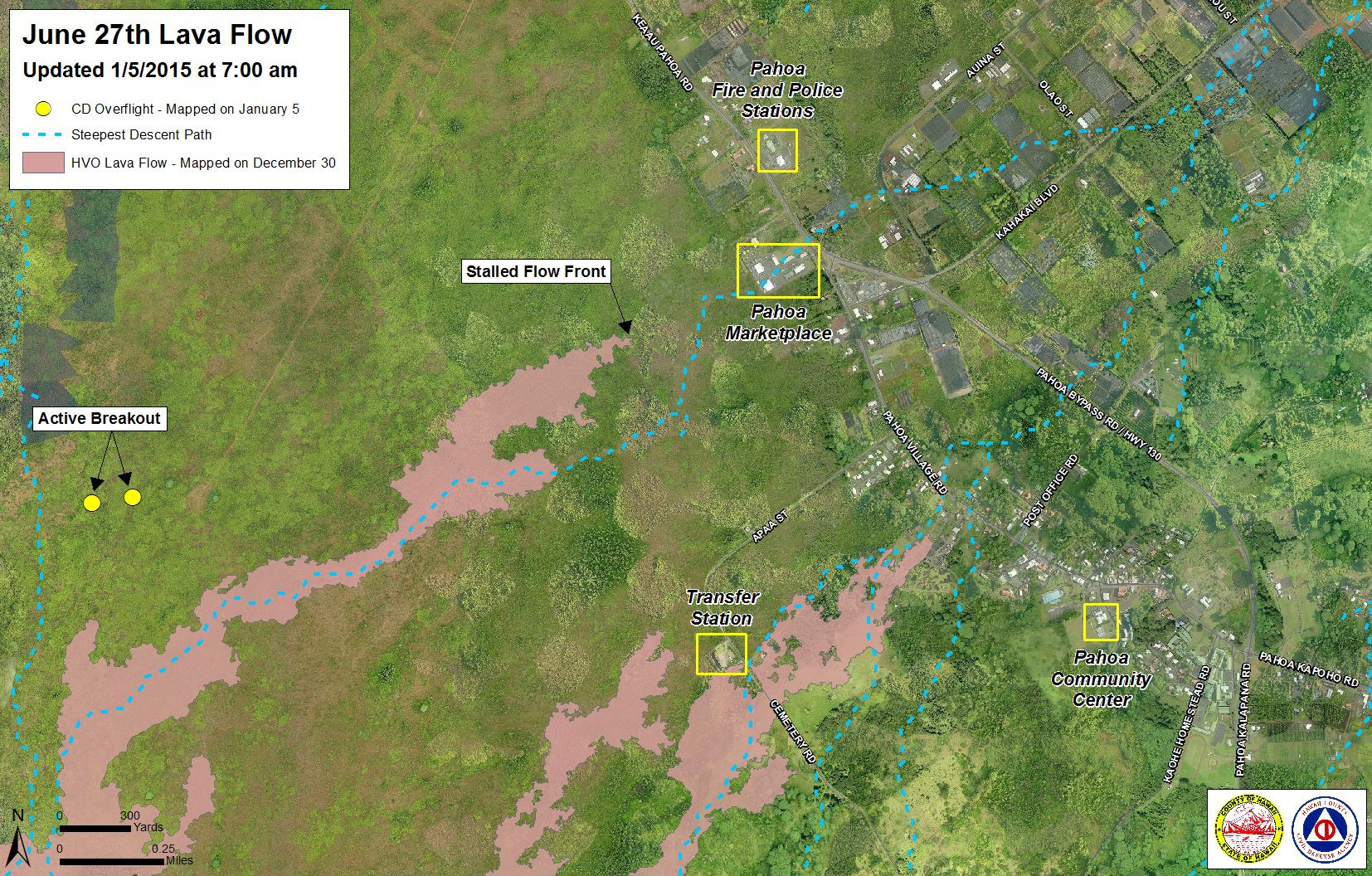(ABOVE MAP) A January 4 satellite image of area around the front of Kīlauea’s East Rift Zone lava flow, courtesy USGS Hawaiian Volcano Observatory
NEWS BRIEFS
- The flow front remains stalled, however breakouts along the north margin are showing signs of increased activity and their advancement is being monitored closely.
- The two breakouts are 1 to 1.5 miles upslope, behind the flow front, and they have advanced about 200 yards since yesterday. Officials say it is too early to see which path of steepest descent they may favor.
- On Wednesday at noon, the county will be closing the Railroad Avenue alternate route to be re-opened if Highway 130 is again directly threatened by lava.
- The county will be scheduling a meeting with the businesses of Pahoa Marketplace to talk about the immediate future, however it may be too early to move back. A meeting is being planned for merchants to be held soon.
MEDIA
Today’s media conference call with Hawaii County Civil Defense and USGS (11:30 p.m. HST):
PRIMARY SOURCES

This morning’s assessment shows that the flow front and south margin breakout remain stalled and there has been no advancement since Friday. The front or leading edge is located .5 miles upslope of the Highway 130 and Pahoa Village Road intersection and approximately 660 yards from the Pahoa Market Place complex. Two breakouts along the north margin approximately 1-1.5 miles upslope or behind the flow front are showing signs of increased activity and advancement and will be monitored closely. Other surface breakouts and activity along both margins continues upslope however, current activity does not pose an immediate threat to area communities. Civil Defense and Hawaiian Volcano Observatory personnel are maintaining close observations of the flow. Residents and businesses down slope will be kept informed of any changes in flow activity, advancement, and status.
Smoke conditions were moderate this morning with a light north/northeast wind blowing the smoke in a southwest direction. Smoke conditions may increase in some areas and individuals who may be sensitive or have respiratory problems are advised to take necessary precautions and to remain indoors.
On behalf of the Hawaii County Civil Defense Agency and our partners we would like to thank everyone for your assistance and cooperation.Hawaii County Civil Defense on Jan. 5 at 7:15 a.m. HST

Civil Defense Lava Flow Map – Updated Monday 1/5/15 at 7:00 am

Kīlauea Volcano continues to erupt at its summit and within its East Rift Zone. In the East Rift Zone, the June 27th lava flow front remained stalled, however, active surface breakouts up slope of the flow front continue. According to Civil Defense, two breakouts along the north margin of the flow approximately 1.5 – 2.5 km (1.0-1.5 miles) up slope of the flow front are showing signs of increased activity and advancement. There has been no significant change in ground tilt over the past day at the summit or at Puʻu ʻŌʻō.
June 27th Lava Flow Observations: HVO webcam images show that active surface breakouts up slope of the flow front continue. This morning, Civil Defense reported that the flow front was still stalled approximately 800 m (0.5 miles or 880 yards) from the intersection of Highway 130 and Pāhoa Village Road, and about 530 m (580 yards or 0.3 miles) up slope of the Pāhoa Marketplace. Two breakouts along the north margin of the flow approximately 1.5 – 2.5 km (1.0 – 1.5 miles) up slope of the flow front are showing signs of increased activity and advancement. The next HVO over flight is scheduled for this week, weather permitting.
Puʻu ʻŌʻō Observations: Very weak inflationary ground tilt was recorded at Puʻu ʻŌʻō yesterday afternoon through early this morning. All other monitoring data indicated no significant changes at Puʻu ʻŌʻō. The most recent measurement of sulfur dioxide emissions from all East Rift Zone vents was about 250 tonnes per day on December 19, 2014.
Summit Observations: There has been no significant change in ground tilt at the summit since December 30, 2014. A typical number of small shallow earthquakes occurred in the summit area. The summit lava lake has shown the usual fluctuations associated with changes in spattering behavior, which are also manifested as variations in tremor amplitudes and gas release. Small amounts of particulate material were carried aloft by the plume. The average emission rate of sulfur dioxide was around 6,000 tonnes/day for the week ending on December 31USGS Hawaiian Volcano Observatory on Jan. 5 at 8:54 a.m. HST

by Big Island Video News12:30 pm
on at
STORY SUMMARY
The flow front remains stalled, however breakouts a mile upslope have moved 200 yards over the last day.